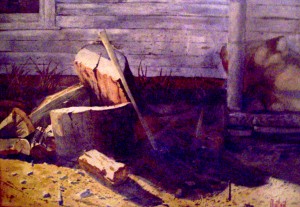If you paint several parallel but separated one-half inch lines of different colors on a white sheet of paper and place a vertical object nearby and then shine a bright light at an angle so the object casts a shadow across the painted lines, you can see how different the shadow appears as it crosses each color. This is a good exercise and practice when painting a picture that requires shadows, because the color of the surface over which the shadow falls has a lot to do with how the shadow looks.

A good painting will have an area painted without a shadow and then the shadow painted over it. Shadows are a great tool for describing shapes they fall upon.
The shape of the surface will alter the shape of the shadow. Please note how the shadows follow the contour of the surfaces in the picture to the right.
Since the shadows follow the contours of the surfaces, artists can use this to help describe their paintings, such as the spilling of shadows, showing the ups and downs of snow, rocks, trees, grass, foliage, roads, fences, and on and on infinitus.
Since shadows can be so defining, it is up to an artist to “think out” shadows in advance of the painting.
